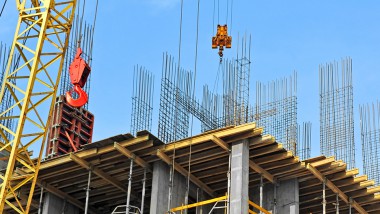Sustainable risk-adjusted returns, through sustainable land use and natural capital
As a nascent but promising market, conservation finance could offer diversified opportunities for institutional investors while fighting global land degradation and deforestation.
Key Takeaways:
- Sustainable land use investments are a relatively new asset class, and have similar growth potential to that seen in renewable energy over the past 10-15 years. Renewable energy funds today manage hundreds of billions of dollars of assets, and sustainable land use is expected to follow the same trajectory.
- Government funding is insufficient to achieve “Land Degradation Neutrality” (LDN), one of the United Nations Sustainable Development Goal targets. More private capital, ideas and expertise are needed.
- Sustainable land use investments offer attractive new investment opportunities for private investors that can produce market-level returns while contributing to sustainable development.
Why has land degradation become such a big issue?
The deterioration of natural capital – or land degradation – is having a severe impact on food security, livelihoods, climate change and biodiversity. Land degradation is caused by activities such as overgrazing, short-term monoculture farming, deforestation, and industrialisation. Basically, natural capital suffers from over-exploitation and underinvestment.
It is estimated that 2 billion hectares of land is degraded worldwide and an additional 12 million hectares of productive land is spoiled every year. According to a study conducted in 2016 by the International Food Policy Research Institute, land degradation has negatively affected 29% of the global land mass. This affects the lives and livelihoods of millions of people in developing countries and also impacts the quality of products sold in developed countries.
Can land degradation be reduced or reversed?
Large numbers of governments and non-government organisations worldwide believe so, and so do we. The concept of “Land Degradation Neutrality” hit the news in 2015 when it was included in the United Nations Sustainable Development Goals. The UN has set a target of achieving LDN worldwide by 2030. LDN aims to maintain or increase the area of healthy and productive land over time. In other words, reaching the LDN objective requires economic growth and development without further land degradation. To date, more than 100 countries have signed up to one or more LDN-related initiatives.
Fighting land degradation also helps to reduce greenhouse gas emissions by preventing deforestation and over-farming. There is also potential for further reduction through low-emissions agriculture, agro-forestry and ecosystem restoration.
Are projects to prevent or reverse land degradation already up and running?
Yes, and they have been for many years. Agroforestry and agroecology projects, combining sustainable production of raw materials (e.g. food and fibres) and nature conservation, as well as inclusion of local communities, have been developed in many regions across the world. They have demonstrated they can generate multiple benefits, including environmental, social and financial results.
This kind of productive financing is no wish list; it is taking place right now. Examples of existing initiatives include a combined sustainably managed rubber plantation and conservation reforestation program in South-East Asia, which has led to increased productivity, new jobs and reduced deforestation. Another example is a climate-resilient coffee restoration and productivity enhancement program in South America. With co-operatives acting as key partners to channel capital to local farmers, this project has sustainably increased yields and raised incomes.
Hundreds of similar projects are underway across the globe. That being said, it still requires a great deal of time, effort and expertise for us to identify these triple bottom line ventures that can contribute to LDN.
How could existing and new funding sources channel further capital into the sector?
Public entities have long devoted resources to sustainable land practices. Support for LDN investments is demonstrated by the growing number of countries that have committed to combat land degradation. However, public and philanthropic funding is not sufficient to finance all the projects and initiatives required to achieve LDN worldwide. Private capital, ideas and expertise are needed, and there is currently considerable focus on how to involve the private sector in sustainable development. Through blended finance - a phrase which is now commonly heard at meetings of the IMF, World Bank and the WEF - public money is used to increase private investment in projects that can have positive development impact while producing financial returns. This money tends to provide the most risky, junior financing for these undertakings, and acts as a catalyst for private investors by reducing their risk exposure. The blended finance model has great potential for increasing private investment: typically, for every $1 invested by public entities into projects, private investors provide $1-$202 .
The sector is still a niche - do you see investing in natural capital going mainstream?
We view the sustainable land use market as similar to renewable energy 10-15 years ago. Back then, renewable energy was a collection of new assets and technologies, with a limited track record and little access to bank finance. Initial projects were funded by public entities and then using a blended finance scheme, just as sustainable land use is today. Now renewable energy is a mainstream investment category and there are hundreds of renewable energy funds managing billions of dollars. We believe that natural capital investments such as sustainable land use will turn into a popular asset class in the near future.
How are consumer preferences driving investment into this new sector?
Many consumer and high street companies are starting to recognize the importance of sustainability for their brands, and are looking for certified commodities. They are prepared to pay a premium for sustainably-produced commodities, such as coffee, cocoa, tea and cotton, grown in accordance with specific environmental and social standards. Unilever, for example, has committed to achieving zero net deforestation by 2020 in its production of palm oil, soy, paper and board, and beef. Adidas is a pioneer member of the Better Cotton Initiative and has committed to using 100% Sustainable Cotton by 2018. Meanwhile, IKEA aims to source 100% of its wood from recycled and FSC-certified sources by 2020. As demand for commodities sourced in this way grows, so this nascent market grows, providing new investment opportunities. It is not just a matter of reputation for corporations; they see it as an opportunity to rethink and secure their supply chains over the long term, in an environmentally and commercially sustainable way.
What is your investment strategy?
We focus on long-term profit-seeking investments in large-scale land restoration and land degradation avoidance projects, which aim to integrate smallholders and local communities. Although we operate worldwide, we have a targeted allocation of at least 80% in developing countries, mainly investing in sustainable agriculture and sustainable forestry, and to a lesser extent in green infrastructure and ecotourism.
Our approach seeks attractive financial returns: using improved agronomic practices increases yields and product quality, while certifications such as Fairtrade, Rainforest Alliance and FSC attract premium pricing. It’s worth saying that the environmental and social (E&S) aspects of every investment opportunity we review are as important as any other financial considerations. As a critical component of our decision-making process, an E&S due diligence is systematically conducted before proceeding with any transaction, and we only consider projects that we believe can make a significant contribution to LDN.
How well is Mirova positioned within this market?
With a long-lasting commitment to responsible investing, Mirova has a proven track record of providing sustainable development finance and allocating capital to projects with positive impacts. We combine this with innovative and flexible financing techniques. It is unusual, particularly in this young sector, to possess these two types of skills.
Besides, the planned acquisition of London-based impact investment manager Althelia by Mirova would represent a major step forward in our ambition to become the European leader in natural capital investing. Althelia is dedicated to sourcing and financing sustainable land use, biodiversity, and ecosystem-based climate activities, with an emphasis on blended value investments that seek to deliver the highest calibre social, environmental and economic performance. Combining Mirova’s existing project finance capabilities, its environmental, social, and supply chain experts with Althelia’s proven technical expertise, recognized know-how and four-year track-record in conservation finance would create a European platform dedicated to natural capital investing, operating from London and Paris. These resources would provide the strategic vision for growth, strong investment processes, and support functions needed to scale up this natural capital investing business.
In other words, we believe we have the requisite reach, experience, resources, and more importantly, the willingness to address this nascent market by developing profit-generating solutions to fight global land degradation and deforestation.
We have a number of competitors, but we view them more as collaborators than rivals, and we work with them to pool skills, ideas, and investment opportunities.
Are returns comparable with mainstream assets?
We mainly provide long-term debt, but we can also access some of the upside in case of strong performance or if the project is sold to a third party. In this sense, our strategy is similar to a mezzanine fund. We pla n to offer different classes of shares with different risk-return profiles.
In the initial stages of a project there is usually a sizeable upfront capex investment, so returns only tend to flow when this phase is over. Over the lifetime of the project – we see 15 years as the appropriate timeframe – returns are expected to be in the 7%-10% range. Most investors are happy with this level of returns given that the risk to their capital is mitigated by the blended finance structure.
How might this strategy fit into investors’ portfolios?
The sector is not yet mature, so investors do not always find it easy to find the right allocation bucket for it. Infrastructure and renewable energy encountered a similar challenge when they first took off. So far, many investors have included it in their responsible investment or impact finance allocations. However, a number of large Dutch and Nordic institutional investors have made sizeable allocations and view the asset class as a key component in their portfolios going forward. In addition, natural capital is a good portfolio diversifier. Not only is it decorrelated from financial markets, but it is genuinely geographically-diversified, with projects being launched in all emerging markets and in some developed markets too. The strategy can be implemented successfully in countries where capital markets are immature or inefficient, thus providing wider geographic diversification than traditional bond or equity funds.
Do you have a final message for would-be investors?
Most people accept that humans are overexploiting nature while underinvesting in it. Investors have an opportunity to improve living conditions for millions of people, enhance the environment, and combat climate change. At the same time, by investing in sustainable land use projects, they can access good returns while seeking to mitigate the risk.
Published in July 2017
MIROVA
A subsidiary of Natixis Asset Management
Limited liability company
Share Capital: € 7 461 327,50
Regulated by the Autorité des Marchés Financiers (AMF) under n° GP 02014.
RCS Paris n°394 648 216
Registered Office: 21 quai d’Austerlitz - 75 013 Paris France
www.mirova.com
This communication is for information only and is intended for investment service providers or other Professional Clients. The analyses and opinions referenced herein represent the subjective views of the author as referenced unless stated otherwise and are subject to change. There can be no assurance that developments will transpire as may be forecasted in this material.
Copyright © 2017 Natixis Investment Managers S.A. – All rights reserved





 Equity Infrastructure: Decorrelated, Long-term Income
Equity Infrastructure: Decorrelated, Long-term Income
 The Real Impact of Carbon on Portfolios
The Real Impact of Carbon on Portfolios